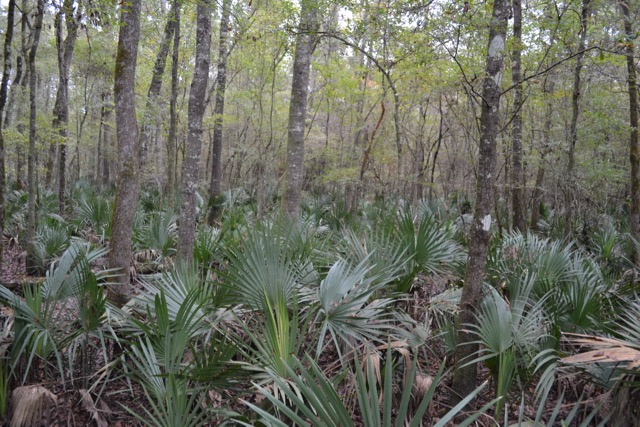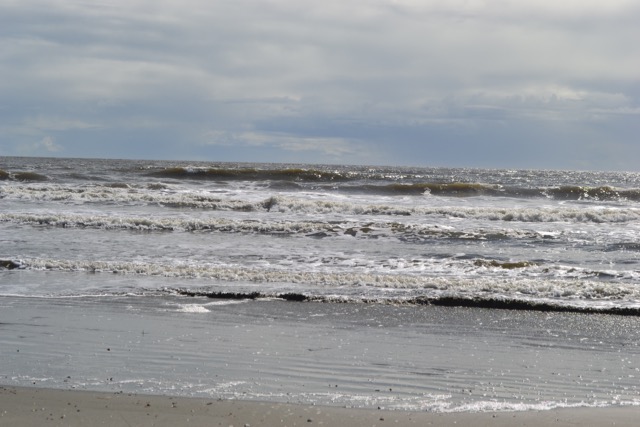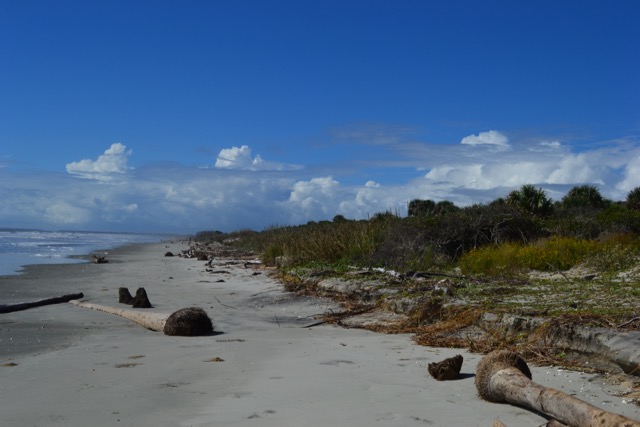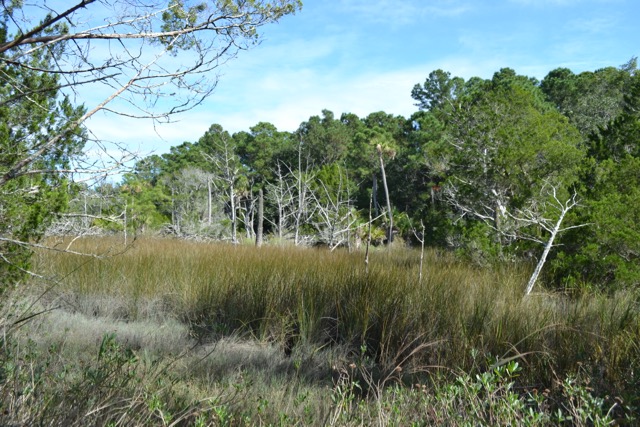The closing of businesses resulting from the pandemic included the Audubon Center at Beidler Forest in Harleyville, SC. The 1,763-acre virgin swamp forest is part of Four Holes Swamp. After it’s reopening In October, I made the drive up I-26 for a visit.
The short trail into Beidler’s 1.75-mile boardwalk began by the closed visitor center, and transitioned into bottomland hardwood forest.  The prevalence of dwarf palmetto Sabal minor indicated the higher elevation compared to what I would find further on. I soon entered the flooded swamp forest, and stands of mature cypress and tupelo.
The prevalence of dwarf palmetto Sabal minor indicated the higher elevation compared to what I would find further on. I soon entered the flooded swamp forest, and stands of mature cypress and tupelo.  Flooded is a relative term in the swamp, since the seasonal variation is great. Several places were marked along the boardwalk noting the flood level of the great inundation in 2015. Signage also documented the destruction to the forest caused by Hurricane Hugo here in 1989, and the variable level of canopy loss – 80% of upland, 10% of cypress sites.
Flooded is a relative term in the swamp, since the seasonal variation is great. Several places were marked along the boardwalk noting the flood level of the great inundation in 2015. Signage also documented the destruction to the forest caused by Hurricane Hugo here in 1989, and the variable level of canopy loss – 80% of upland, 10% of cypress sites.
This swamp was the forest community once populating the Santee Delta that I had sought to more fully understand. The Beidler Forest has a more specific ecosystem name – a blackwater cypress-tupelo creek swamp, differing from the Santee Delta swamp forest that was predominately brownwater and had tidal influence. Yet the species and forest were similar, and Beidler gave a good feel for the distribution of trees. 
The canopy heights varied with the tree diversity distributed throughout the forest. The visual density of the forest contrasted with the acoustics. The quiet was profound, and only briefly disturbed by the scream of a pre-adolescent visitor. Listening carefully, at one stop, the patter of falling leaves was a soft gentle rustling of the sonic world.
Individuals of the Beidler Forest stood out. There was no appearance from the “mascot” of Beidler. National Parks and Refuges regularly market their identity from a flagship or charismatic species: Great Smoky Mountains National Park has the black bear, Waccamaw National Wildlife Refuge has the swallow-tailed kite, and Beidler, though not in the National Park or Refuge systems, has the prothonotary warbler, a beautiful golden flash in the swamp. Many old growth cypress invited a closer look, one documented with an age of 1000 years. I was interested to see a labeled tree unfamiliar to me – pumpkin ash Fraxinus profunda – but did check later with staff to make sure it was not a Halloween spoof. Besides the glorious individual trees, a duo caught my eye. Two trees were joined “at the hip”, and I viewed and photographed from various angles this cypress and sweetgum union. In the past I have marveled at various conjoined trees in nature, and recalled the myth of Philemon and Baucis.
I was interested to see a labeled tree unfamiliar to me – pumpkin ash Fraxinus profunda – but did check later with staff to make sure it was not a Halloween spoof. Besides the glorious individual trees, a duo caught my eye. Two trees were joined “at the hip”, and I viewed and photographed from various angles this cypress and sweetgum union. In the past I have marveled at various conjoined trees in nature, and recalled the myth of Philemon and Baucis.

Cypress knees added their own character to the swamp, and one individual departed from the usual stalagmite form.
Though not a mascot, the water moccasin is a charismatic species (for some) of Beidler, and the reception staff person had alerted me to an individual hanging out around marker #18 on the boardwalk. I had forgotten to be on the alert, but saw the movement as the sizable reptile dropped off the planking into the water. Its submerged body was visible on the bottom, its distinctive markings showing through the tannin-stained waters. I waited to point out the snake to two other visitors coming along before completing the loop walk.
* * *
For various reasons, I changed my planned hike on Bull Island away from a longer loop walk taking in some miles on the beach in preference for a more forested path. After passing the Lower and Upper Summerhouse Ponds, and then heading north on the Mills Road, I found myself in a lush section of Bull’s maritime forest, having achieved a healthy level of regeneration post Hurricane Hugo’s devastation. The island’s topography was most visible, with forested Pleistocene ridges brimming with live oaks. Throughout this forest, the live oaks were joined in the canopy by cabbage palmetto, loblolly pine, laurel oak, Southern magnolia, and American holly; the understory was composed of such smaller trees and shrubs as Southern red cedar, sweet and red bay, wax myrtle, yaupon holly, and beauty-berry.
Throughout this forest, the live oaks were joined in the canopy by cabbage palmetto, loblolly pine, laurel oak, Southern magnolia, and American holly; the understory was composed of such smaller trees and shrubs as Southern red cedar, sweet and red bay, wax myrtle, yaupon holly, and beauty-berry.
As at Beidler, the elevation changes impacted the forest community, and on Bull Island the parallel ridges formed from ancient sand dunes contained sloughs often holding water. These natural depressions between ridges were exploited in the past to build impoundments. These diked ponds, a manmade transformation of the terrain, are just one of the reasons that Bull Island does not qualify for the Class I wilderness designation of almost 50% of Cape Romain National Wildlife Refuge. They have provided significant habitat for wildlife, notably migratory waterfowl, wading birds, and the large population of American alligators.
These natural depressions between ridges were exploited in the past to build impoundments. These diked ponds, a manmade transformation of the terrain, are just one of the reasons that Bull Island does not qualify for the Class I wilderness designation of almost 50% of Cape Romain National Wildlife Refuge. They have provided significant habitat for wildlife, notably migratory waterfowl, wading birds, and the large population of American alligators.
Unlike the quiet hush at Beidler, this barrier island had a constant drone of surf. It was resounding from the marsh and throughout the maritime forest; I had heard the far off murmur from my porch in Awendaw. Upon stepping out on the sand past the dunes, the higher than normal surf was the source for the persistent low roar.

After a brief visit to the high tide flooded beach, I continued my walk along the Turkey Walk Trail through the maritime forest and across the Summerhouse Dike. In the distance, the long black tail confirmed the ID of a fox squirrel. I had noted the reopening of the long closed leg of the Turkey Walk Trail off this dike, and I set out to enjoy this narrow forest and marsh trail.
The rebuilding of the trail included more substantial walkways over low-lying areas.
 The beauty of the path continued to be a meandering passage through the edge of the maritime forest, black needle rush marsh transitioning to Spartina marsh, and the views out to the Cape Romain marshes, hammocks, and mainland in the distance. Here the impact of water on the ecosystem has been profound, shaped by the combined forces of saltwater and tide.
The beauty of the path continued to be a meandering passage through the edge of the maritime forest, black needle rush marsh transitioning to Spartina marsh, and the views out to the Cape Romain marshes, hammocks, and mainland in the distance. Here the impact of water on the ecosystem has been profound, shaped by the combined forces of saltwater and tide. 
Thanks as usual Bob for this interesting description of two fascinating local wildlife locations! Rod
🙂 Came through fine 🙂 I know exactly were the one cypress knee is at Beidler 🙂 To me It always looks like a creature about to crawl out of the water OR that it is a safe place for a creature to hide from bad weather 🙂
Yes that knee has some character: distinctive, and right next to the boardwalk. Someone has probably named it.
Good to hear from you again Bob. Made me think of the time we went looking for a record alligator on Bull. Your travels inspire me to keep my eyes open. Thanks
Despite lots of tech issues here, it is all worth while to hear from my old friend. And thanks for that reminder of keeping the eyes open.
As always, I enjoyed reading of your adventures. I laughed when I read of your encounter with your reptilian friend on the boardwalk. It reminds me of the many times, while being focused on the sights around me during my adventures, I’ve neglected to look where I am walking and tripped up or almost stepped on something I might regret. Take care!
An upcoming post will have a furry animal stepping out in front of my path.
Henry, I’m updating this reply since I realized it is not just important to look down. Riding my bike down to landing and past impoundment, a bald eagle with a large fish in talons flew right over me on way to roosting tree for a fine breakfast. So look all around.
Bob,
Very nice adventures! Every year when we visit Myrtle Beach I want to make a trip to Beidler Forest but never seem to make it. Such a beautiful place and not many places like that left on the East coast. I can picture Francis Marion trekking around there!
Yes, Beidler is a must see. Well worth the visit as is Congaree National Park. Incredible forest remnants.
Thanks for the Nature walk and lesson.
You always inspire me to look and see the beauty around us. You’re very familiar with the world around you. Appreciate you sharing and will get out there someday!
Dana
And you have beauty all around you at Bennett’s Point, and your monarch nursery.